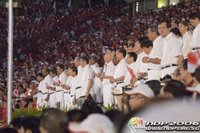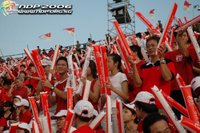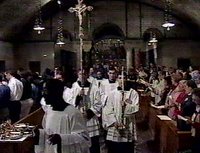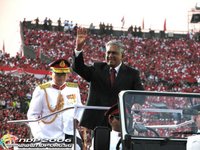Civil Religion in Singapore?
We tend to think of the state as a secular entity, and of religion as being of a divine form of beliefs. However, Rousseau has proposed the idea of a civil religion, which consists of the full set of political doctrines, historical narratives, exemplary figures, celebratory occasions and memorial rituals through which the state impresses itself upon the minds of its members, specially its youngest or newest members.
In Singapore today, most people do not think of social hierarchy rigidly, but quite the opposite. Most Singaporeans celebrate the alleged absence of social hierarchy. This is part of what sociologist Robert Bellah calls our civil religion (this term was first coined by Rousseau), a set of quasi-religious beliefs and practices that bind the population and justifies our way of life.
When we think of Singapore as a meritocracy, where everyone can realize the ‘Singaporean Dream’ (regardless of race, language or religion), as a place in which individualism and free enterprise ensures maximal benefit for all, we are giving voice to a certain Singaporean civil religion.
Paradoxically, however, our civil religion may also help to divert our attention from the inequalities that persist in our society. A strong belief in equal opportunity for all, may for instance, lead people to overlook the reality that the lack of opportunity remains in our society.
DE-CONSTRUCTION OF NDP?
In this post, I would like to cursorily de-construct the National Day Parade, a good manifestation of what is meant by Rousseau when he suggests a civil religion.
Apart from drawing one of the largest television audiences, the NDP generates a sense of what Durkheim (a sociologist who focused on the functionalist approach to studying social phenomena) would have called “collective effervescence”. That is, the NDP excites us by making feel like we belong to a community that is much larger than our individual selves. For 2-3 hours each year, Singaporeans who participate in the celebration (even by just watching on TV) transcend their everyday lives and experience intense enjoyment by sharing the sentiment and values of a larger collectivity. In their fervor, they banish thoughts of their own mortality (and also perhaps get over their regret over not booking a holiday in time and going overseas). They gain a glimpse of a prosperous future for themselves and their descendants as they immerse in institutions that will outlast them and ‘national’ achievements (like Team Singapore’s scaling of Mount Everest) that people will remember for generations to come.
This “collective effervescence” is one of the rare occasions where people actually come together and actually feel Singaporean. It is also probably the closest thing you could ever witness to four million smiles, I guess. The only other occasions when I feel Singaporean is when I spot fellow Singaporeans by the NTUC plastic bags they carry while shopping in Johor or when you see familiar faces while relaxing at the not-so-integrated resorts at Genting.
TOTEMS?
We designate certain objects as symbolizing the sacred, objects which Durkheim called totems. While spiritual religions may have overt items like statues, crosses and chalices as totems, civil religions similarly have their totems, though they may not be that overt, which is also why I think it is more insidious.
Using the case study of NDP, we can see many totems of civil religion.
In this picture shown here, the obvious totems are the multitude of flags being used, not to mention the giant state flag used in the regular helicopter fly-past. But if you pay attention to the top left corner of the photo, you will notice an interesting phenomenon that the Parliament bloc is dressed in party colours of white, amidst a red fervent background of enthusiastic Singaporeans. Well we have all heard many unofficial explanations for this anomaly and I’m not about to dwell on them in this post. (Which sometimes also prompts me to ask, where are the opposition MPs in their party colours?)


I would like to offer something in line with this idea of a civil religion, where it almost seems as if the MPs have to deliberately dress differently from the rest of the madding to suggest notions of superiority. Indeed one can argue that it is just their party colours, but seriously, they look almost like the clergy, who have a religious duty to serve the masses. I used to be very puzzled why politics had anything to do with a national celebration, or nationalism. Now that I see Durkheim’s suggestion that such a religious belief in certain ideas functions like a social cement, yes it does seem that such a move helps to entrench certain ideas we have about certain groups and institutions. In short, we might be more inclined to accept our lot in life and the way things are, after we experience and complete such rituals.

By chance, I noticed this uncanny similarity also. I shall restrain myself from reading too much into it, but all I can say is that the Presidential drive-past it itself a totem, and is part of the many rigid rituals that characterizes the NDP. The rigid line-up of events, all synchronized to a perfect timing through countless rehearsals, combined with the many totems that are paraded throughout the NDP all work together to reinforce social solidarity. We suspend our everyday lives as we watch the whole ritual of NDP being enacted. The ritual heightens our experience of belonging to certain groups, which in turn panders to the theme for the year (a CMIO multi-racial family, forward-looking IT nation, etc), increases our respect for certain institutions, and strengthens our beliefs in certain ideas. These groups, institutions and ideas all transcend us, thus fulfilling the sacred nature of the event.
Indeed, there is much more about NDP to be de-constructed as a ritual. I myself, having served the last half of my NSF life working for NDP 2007 & struggling with its continued relevance to today’s society would definitely like to spend more time and effort researching into this area if my studies allow. I hope it has been intriguing to offer to conceptualize this idea of NDP as a civil religion.

<< Home